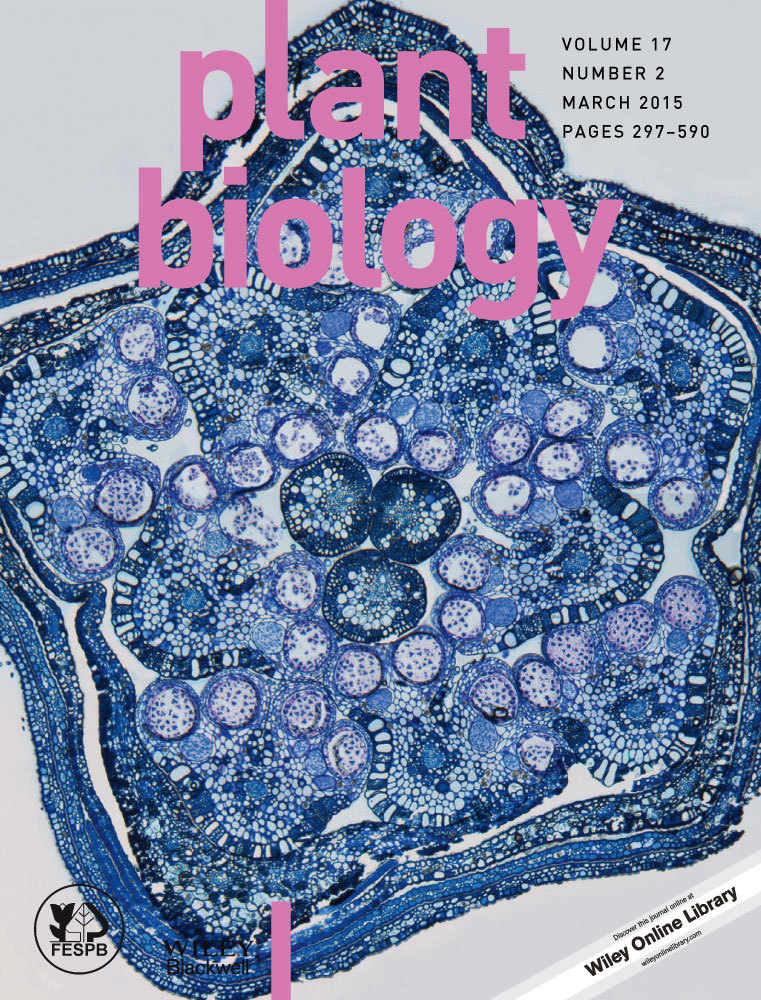Seed dormancy and germination in Jeffersonia dubia (Berberidaceae) as affected by temperature and gibberellic acid
Abstract
The genus Jeffersonia, which contains only two species, has a trans-Atlantic disjunct distribution. The aims of this study were to determine the requirements for breaking dormancy and germination of J. dubia seeds and to compare its dormancy characteristics with those of the congener in eastern North America. Ripe seeds of J. dubia contain an underdeveloped embryo and were permeable to water. In nature, seeds were dispersed in May, while embryos began to grow in September, and were fully elongated by late November. Germination started in March of the next year, and seeds emerged as seedlings soon after germination. In laboratory experiments, incubation at high temperatures (25 °C, 25/15 °C) for at least 8 weeks was required to initiate embryo growth, while a transfer to moderate temperatures (20/10 °C, 15/6 °C) was needed for the completion of embryo growth. At least 8 weeks at 5 °C was effective in overcoming physiological dormancy and for germination in seeds after the embryos had fully elongated. Thus, both high and low temperatures were essential to break dormancy. Gibberellic acid (GA3) treatment could substitute for the high temperature requirement, but not for the low temperature requirement. Based on the dormancy-breaking requirements, it is confirmed that the seeds have deep simple morphophysiological dormancy. This dormancy type is similar to that of seeds of the eastern North American species J. diphylla. Although seeds require 10–11 months from seed dispersal to germination in nature, under controlled conditions they required only 3 months after treatment with 1000 mg·l−1 GA3, followed by incubation at 15/6 °C. This represents practical knowledge for propagation of these plants from seed.
Introduction
Seeds of many species in temperate regions of the northern hemisphere have underdeveloped embryos that must grow inside the seed before germination occurs (Baskin & Baskin 1998). If embryo growth and germination of these species are completed at suitable temperatures in about 30 days or less without a dormancy-breaking pretreatment, seeds will have morphological dormancy (MD) (Nikolaeva 1977; Baskin & Baskin 1988). However, if seeds with underdeveloped embryos require more than 30 days to complete germination, they have both morphological and physiological dormancy, which is known as morphophysiological dormancy (MPD) (Nikolaeva 1977; Baskin & Baskin 1998). An extensive study on the ecophysiology of dormancy and the germination of seeds of forest herbs with MPD has been conducted for species of the eastern deciduous forests of North America (Baskin & Baskin 1988). Several studies have also been published on the requirements for breaking dormancy of seeds of species with MPD in temperate deciduous forests in Europe and Japan (Vandelook & Van Assche 2009; Kondo et al. 2011; Mondoni et al. 2012). However, few studies have been conducted on the phenology and temperature requirements for dormancy breaking and germination of seeds with underdeveloped embryos in species of broadleaved, deciduous forests in Korea (Lee et al. 2012).
Jeffersonia dubia (Maxim.) Benth. & Hook. F. ex Baker & S. Moore (Berberidaceae) is a herbaceous perennial, distributed in northeast Asia, from southern Korea to northeast China and eastern Siberia (Hutchinson 1920; Krestov et al. 2006). J. dubia is an early-flowering plant that develops flower shoots and leaves from the bulb at the base of plant. Reproductively mature individuals are 10–30-cm high, with light violet flowers and attractive heart-shaped leaves. Thus, this plant is regarded as a new ornamental crop for the garden (Huang 1994). J. dubia has the potential to be used for medicinal purposes, as well as ornamental planting. Extracts of J. dubia roots are used in folk medicine as antidotes for stomach-ache (Bae 2000). Duke & Ayensu (1985) purified a compound from J. dubia roots, named berberine, which was identified as a promising cholesterol-lowering drug that acts through pathways that are distinct from those affected by statins (Kong et al. 2004). However, in the Korean Peninsula, J. dubia is a very rare and threatened species, with only a small population in deciduous woodlands due to extensive collection and replacement of natural areas (Kim 2006). Thus, it is important that efforts should be made to prevent the disappearance of J. dubia. This plant can be reproduced through root cuttings, but this method is very time-consuming, expensive for producing seedlings and reduces genetic variability of the future populations. Therefore, efficient seed-based propagation methods are needed.
J. dubia seeds cannot immediately germinate after dispersal in late spring. It takes more than 10–11 months for seeds of J. dubia to germinate under field conditions. J. dubia seeds have an underdeveloped embryo at seed maturity (dispersal), and this embryo has to grow inside the seed before the seeds can germinate (Grushvitzky 1967; Lee et al. 2012). A study on the embryo growth of seeds of J. dubia indicated that embryo growth occurs at 20 °C (Grushvitzky 1967). Gibberellins (GAs) are plant hormones that regulate growth and influence various developmental processes, including stem elongation, germination, dormancy, flowering, sex expression, enzyme induction and leaf senescence (Baskin & Baskin 1998). Embryos of GA-treated seeds of J. dubia were fully developed after 1 month at 20 °C, but only 4% of the seeds germinated (Grushvitzky 1967). Warm and/or cold stratification can break dormancy in seeds of many species (Baskin & Baskin 1998). Periods of (moist) cold stratification (4–5 °C) for up to 30 days could increase germination percentage and rate in the herbaceous perennial species, Liriope spicata (Lee et al. 2006) and Megaleranthis saniculifolia (Lee et al. 2003). However, moist chilling at 5 °C for 8 weeks did not increase the germination percentage in J. dubia (Lee et al. 2007). These results did not explain why seeds of J. dubia require warm and/or cold stratification for germination. The genus Jeffersonia includes only two species that exhibit an eastern North American–eastern Asian disjunct distribution (Li 1952). Jeffersonia diphylla (L.) Pers. is native to northern temperate regions of North America, and the conditions required for breaking its dormancy and for germination have been well studied. Seeds of J. diphylla require warm stratification followed by cold stratification for dormancy breaking, their embryos grow at warm temperatures, and GA3 substitutes for warm stratification (Baskin & Baskin 1989).
Although there is some information on the embryo growth and germination of J. dubia seeds, a more detailed study is required to determine the factors controlling dormancy and germination in this species. The specific objectives of the present study were to: (i) describe the timing of embryo growth, germination and seedling emergence under outdoor conditions; (ii) experimentally define the temperature requirements for embryo growth and germination; and (iii) determine if GA3 can replace the temperature requirement for embryo growth and germination in this taxon. An additional experiment was performed to test the ability of GA at various temperatures to overcome dormancy.
Material and Methods
Seeds
Seed capsules of J. dubia, consisting of 10–15 seeds, were harvested from a population of J. dubia in Yong-in (37°05′ N, 127°24′ E), Geonggi, Korea, on 26 May 2009, 28 May 2010 and 22 May 2011. Here, J. dubia grows in a mesic deciduous woodland in Hantaek Botanical Garden that is an ex situ conservation habitat. Seeds were removed from the capsules by hand, winnowed and then air-dried at room temperature (22–25 °C) for 2–4 days. Unless otherwise noted, experiments started within 1 week of harvest. Seeds not used immediately in the experiments were put into paper envelopes at 5 °C until they were used in germination tests and for observations on embryo growth.
Imbibition of seeds
This experiment was performed to determine if seeds have physical dormancy (PY). Three replicates of 30 seeds collected in 2009 were placed on filter paper moistened with distilled water in 9-cm Petri dishes and kept in the laboratory at room temperature (22–25 °C). Seeds were weighed to the nearest 0.1 mg at various times after incubation for 60 h. Seed mass was determined at 0.5-h intervals for the first 12 h, and then every 12 h for the next 60 h. Percentage water uptake (%Ws) was calculated as %Ws = [(Wi − Wd)/Wd] × 100, where Ws = increase in mass of seeds, Wi = mass of seeds after a given interval of imbibition, and Wd = mass of dry seeds.
Phenology of embryo growth, germination and seedling emergence
The aim of these studies was to describe the phenology of embryo growth, germination and seedling emergence from seeds kept under near-natural temperature conditions. Seeds were placed in fine-mesh polyester bags and buried in pots or trays filled with potting soil on 8 June 2010. Pots and trays were placed in an experimental garden in the campus of Seoul National University, Seoul, Korea. The soil temperature at a depth of 3 cm was measured every 30 min with a thermo-data logger (Watch Dog Model 450; Spectrum Technologies, Inc., Plainfield, IL, USA), and weekly maximum and minimum temperatures were calculated (Fig. 2).
Each of the 25 fine-mesh polyester bags filled with 20 seeds and 10 g of white sand was buried at a depth of 3 cm in the experimental garden. On days 8 and 23 of every month, ten seeds were removed randomly from one bag, and embryo length was measured from 8 June 2010 to 23 February 2011. Seeds were cut in half under a dissecting microscope using a razor blade, and the embryo length was measured with an ocular micrometer. The ratio of embryo length to seed length (E:S ratio) was calculated.
Germination and seedling emergence phenology was monitored in seeds buried under natural conditions in June 2010. Each of the three fine-mesh polyester bags filled with 100 seeds was buried at a depth of 3 cm in the experimental garden. Seeds with an emerged radicle were counted and removed each week for 1 year. A seed was considered germinated when radicle protrusion occurred and reached 2 mm. Intact seeds that had not germinated were buried again.
Timing of seedling emergence was determined by sowing three replicates of 50 seeds 1-cm deep in plastic pots filled with potting soil. Three replicate pots were buried at soil level in a shady site in the garden. The experiment lasted for 1 year, during which emerged seedlings were counted and removed each week.
Laboratory experiments
Seeds were treated with 500 mg·l−1 benomyl for 3 h for bacterial control before being used in laboratory experiments. Unless otherwise stated, each of the three replicates of 30 seeds each was placed in 9.0-cm diameter plastic Petri dishes lined with two layers of filter paper for GA studies or with sand for temperature studies. The sand used in these experiments was washed with distilled water and sterilised in hot air oven at 80 °C for 48 h. Petri dishes were moistened with distilled water and sealed with parafilm (Pechiney Plastic Packaging, Menasha, WI, USA) to retard water loss during incubation. Experiments were conducted in light- and temperature-controlled incubators using a 12-h daily photoperiod (photosynthetically active radiation 30–40 μmol·m−2·s−1, with light provided by cool white fluorescent lamps). In the alternating regime, the high temperature was given for 12 h with light each day, and the low temperature for 12 h in darkness. At each observation, seeds with an emerged radicle were recorded and removed from the dishes; water was added as needed to keep the seeds moist. The experiments were terminated when no additional germination had occurred for 3 weeks.
Effect of temperature regimes on germination and embryo growth
To determine whether seeds have MD or MPD, seeds were incubated at a constant 5 °C, and at alternating temperature regimes of 15/6, 20/10 and 25/15 °C on 2 June 2010. Observations on germination were made at 7-day intervals. The experiment was terminated 60 weeks after seed incubation. In the experiments looking at embryo growth, ten seeds were removed at random from extra dishes for each temperature treatment at 4-week intervals for 52 weeks, and the E:S ratio of the seeds was measured as previously described.
Effect of warm-to-cold and cold-to-warm temperature sequences on germination and embryo growth
The purpose of this experiment was to determine if warm, cold or warm plus cold stratification treatments were required for embryo growth and germination. On 2 June 2010, seeds were subjected to the following two temperature sequences: (i) beginning with warm temperature 25/15 °C for 12 weeks → 20/10 °C for 4 weeks → 15/6 °C for 4 weeks → 5 °C for 12 weeks, then moving the seeds back to 15/6, 20/10 and 25/15 °C and continuing the sequence if they had not germinated; and (ii) beginning with cold temperature 5 °C for 12 weeks → 15/6 °C for 4 weeks → 20/10 °C for 4 weeks → 25/15 °C for 12 weeks → 20/10 °C for 4 weeks → 15/6 °C for 4 weeks → 5 °C for 12 weeks, then moving the seeds back to 15/6, 20/10 and 25/15 °C and continuing the sequence if they had not germinated. E:S ratio and germination were measured as previously described.
High temperature requirements for germination
This study determined the optimum temperature range and duration for warm stratification. On 7 June 2011, seeds collected in May 2011 were first placed at 20/10, 25/15, 20 or 25 °C for 2, 4, 6, 8 or 12 weeks. After each temperature × duration condition, all seeds were moved through the temperature sequence for germination. The sequence was 20/10 °C for 4 weeks → 15/6 °C for 4 weeks → 5 °C for 12 weeks → 15/6 °C for 4 weeks. This sequence of temperatures simulates natural conditions, where high summer temperatures are followed by autumn temperatures and lower winter temperatures. Germination was measured at the end of incubation at 15/6 °C.
Cold temperature requirements for germination
The purpose of this study was to determine if cold stratification is required for radicle emergence in fully embryo-elongated seeds, and if so, how many weeks of cold stratification are required. On 2 June 2010, seeds were put in a fine-mesh polyester bag and placed in an experimental garden. On 10 November 2010, seeds were removed from their bag. The average E:S ratio of these seeds was 0.675 ± 0.012 (mean ± SE, n = 10). These seeds were transferred to 5 °C for 0, 2, 4, 6, 8, 10 and 12 weeks. Thereafter, seeds were incubated at 20/10 °C and checked for germination after 42 days.
The role of GA3 in breaking dormancy
The ability of GA3 to break dormancy is used to classify seed dormancy types (Baskin & Baskin 1998). On 9 June 2010, seeds were soaked with distilled water (control) or in solutions of 10, 100 or 1000 mg·l−1 GA3 for 24 h at room temperature, prior to incubation. All seeds were incubated at constant 20 °C. After 0, 2, 4, 8 and 12 weeks, the E:S ratio of each seed was measured. At the end of the 12-week incubation period, germination was measured.
Effect of GA3 on germination under various incubation temperatures
In this part of the study, we analysed the effect of GA3 and incubation temperature on final germination of seeds. On 7 June 2011, seeds were soaked in solutions at concentrations of 10, 100 and 1000 mg·l−1 GA3, or with distilled water (control) for 24 h at room temperature, and then incubated at 5, 15/6, 20/10 and 25/15 °C for 12 weeks.
Statistical analysis
The percentage germination after pre-treatment at different temperatures was analysed using anova followed by Tukey's multiple comparison test (SAS Institute, Cary, NC, USA). A two-way anova was also used to test the interaction effect between GA3 concentration and incubation temperature on percentage seed germination.
Results
Imbibition of seeds
Seeds of J. dubia imbibed water readily, and followed a typical pattern of initial rapid water uptake, with the seed mass increasing by 113.6 ± 4.0% (mean ± SE) after 6 h (Fig. 1B) and 144.1 ± 6.4% after 60 h; the seed mass stabilised beyond this point (Fig. 1A).
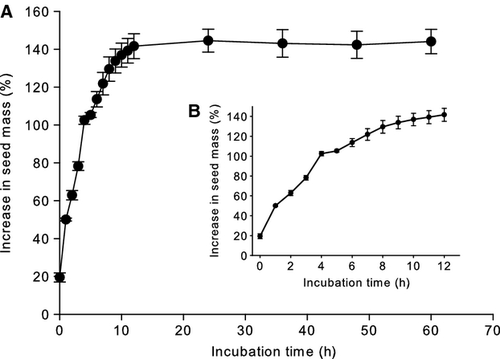
Phenology of embryo growth, germination and seedling emergence
The initial embryo length in June 2010 was 0.40 ± 0.02 mm (mean ± SE), in which the E:S ratio was 0.085 (Fig. 2). Embryos hardly grew during the summer when temperatures were high. The E:S ratio on 8 September 2010 was 0.115. However, between 8 September and 23 November 2010, the E:S ratio increased rapidly to 0.930, in which the mean maximum and minimum soil temperatures during the preceding week were 17.7 and 14.1 °C, respectively. Embryos grew very little after 23 November 2010. Germination began between 23 February and 8 March 2011. On 8 March, 12.5 ± 2.3% of the exhumed seeds had germinated (Fig. 2). Three weeks later, on 27 March 2011, 94.7 ± 4.7% of the seeds had already germinated. On 27 March 2011, emerged seedlings were first observed from 14.8 ± 6.4% of the seeds, and the mean maximum and minimum temperatures during the preceding week were 10.9 and 4.7 °C, respectively. By the end of April 2011, seedlings had emerged from 88.9 ± 11.1% of the seeds.
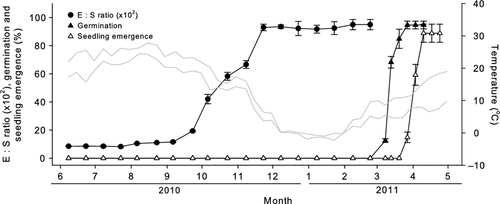
Effect of temperature regimes on germination and embryo growth
No seeds germinated within 52 weeks at the constant temperature of 5 °C, or at any of the three daily alternating temperature regimes of 15/6, 20/10 or 25/15 °C (Fig. 3). Even at 52 weeks after sowing, embryos did not grow at 5, 15/6 or 20/10 °C. At 25/15 °C, embryo growth began between weeks 8 and 12, by which time they had more than doubled in length. However, the E:S ratio increased to only 0.471 after 52 weeks.
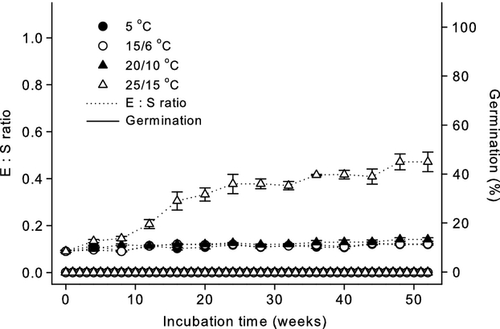
Effect of warm-to-cold and cold-to-warm temperature sequences on germination and embryo growth
For seeds incubated in the temperature sequence beginning with 25/15 °C, the E:S ratio increased to 0.176 during the 12 weeks of incubation at 25/15 °C (Fig. 4A). A rapid increase in embryo length was observed upon transfer from 25/15 °C to 20/10 and 15/6 °C. During 8 weeks of incubation at 20/10 and 15/6 °C, the E:S ratio increased to 0.719. After 8 weeks at 5 °C, the E:S ratio increased to 0.865. At this time, the first seed germinated. Germination began near the end of the 5 °C treatment, and increased rapidly to 84.9 ± 3.6% at 15/6 °C, and then to 88.0 ± 4.4% at 20/10 °C. In the temperature sequence beginning at 5 °C, embryos did not grow until they were moved to 25/15 °C (Fig. 4B). Embryo growth began after 8 weeks at 25/15 °C and the E:S ratio increased to 0.517 at 20/10 °C and then to 0.756 at 15/6 °C. No seeds germinated after 48 weeks of incubation in the temperature sequence that began at 5 °C. Seeds germinated to 22.6 ± 5.2% during the second exposure to 5 °C, reaching 86.6 ± 4.6% shortly after the seeds were transferred to 15/6 °C.
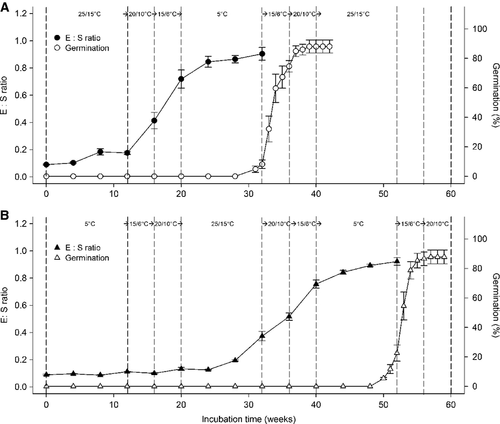
High temperature requirements for germination
The temperature and duration of the pre-treatment significantly (P < 0.05) affected the final germination percentage after the sequence of temperatures: 20/10 °C (4 weeks) → 15/6 °C (4 weeks) → 5 °C (12 weeks) → 15/6 °C (4 weeks) (Table 1). More than 80% of the seeds germinated when seeds were warm-stratified at 25/15 or 25 °C for 8 weeks or at 20 °C for 12 weeks. However, few seeds (<11%) germinated after a pre-treatment at 20/10 °C.
| duration (weeks) | pre-treatment temperature | |||
|---|---|---|---|---|
| 20/10 °C | 20 °C | 25/15 °C | 25 °C | |
| 0 | 0.0 ± 0.0a | 0.0 ± 0.0a | 0.0 ± 0.0a | 0.0 ± 0.0a |
| 2 | 0.0 ± 0.0a | 0.0 ± 0.0a | 0.0 ± 0.0a | 6.0 ± 0.7a |
| 4 | 0.0 ± 0.0a | 5.0 ± 5.0a | 25.7 ± 3.7a | 22.6 ± 6.8a |
| 6 | 0.0 ± 0.0a | 31.9 ± 6.9ab | 64.1 ± 5.4b | 49.5 ± 16.5ab |
| 8 | 6.9 ± 6.9a | 55.0 ± 10.0bc | 89.3 ± 10.3b | 88.4 ± 0.8b |
| 12 | 11.0 ± 11.0a | 82.0 ± 0.8c | 86.3 ± 6.3b | 92.5 ± 2.5b |
- A one-way anova was conducted in order to detect significant differences between weeks under the same temperature regime. Means followed by the same letter within a column are not significantly different at P < 0.05 (Tukey's multiple comparisons test).
Cold temperature requirements for germination
Seeds with fully elongated embryos required a prolonged exposure to cold stratification (5 °C) to reach maximum germination (Fig. 5). Germination was 0% for seeds cold stratified at 5 °C for ≤2 weeks and then incubated at 20/10 °C. However, seeds stratified at 5 °C for 8, 10 and 12 weeks germinated to 76.7 ± 6.7, 83.2 ± 8.2 and 95.0 ± 5.0%, respectively.
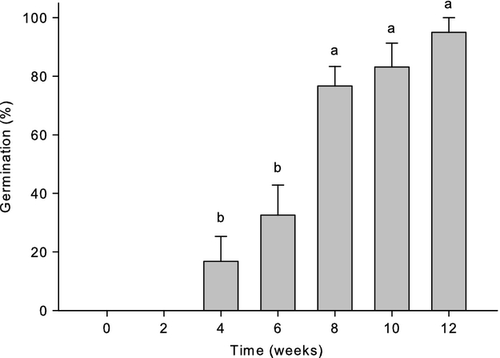
Role of GA3 in breaking dormancy
The embryo length increased with an increase in GA3 concentration (Fig. 6A). However, when seeds were pre-treated with 0 (control), 10, 100 and 1000 mg·l−1 GA3 and re-incubated at 20 °C for 20 weeks, 0, 0, 3.2 ± 1.0 and 10.7 ± 5.0% of the seeds germinated, respectively (Fig. 6B).

Effect of GA3 on germination under various incubation temperatures
The concentration of GA3 and the temperature conditions had significant effects on the final germination percentage after 12 weeks of incubation (P < 0.05; Fig. 7). For all temperature conditions, the final germination percentage increased with increasing concentration of GA3. The germination percentage was highest for seeds incubated at 15/6 °C, while seeds incubated at 25/15 °C had very low germination percentages. The final germination proportions recorded at 25/15, 20/10, 15/6 and 5 °C were 10.6 ± 1.7, 30.1 ± 5.9, 74.2 ± 3.0 and 23.5 ± 2.8% in 1000 mg·l−1 GA3, respectively.
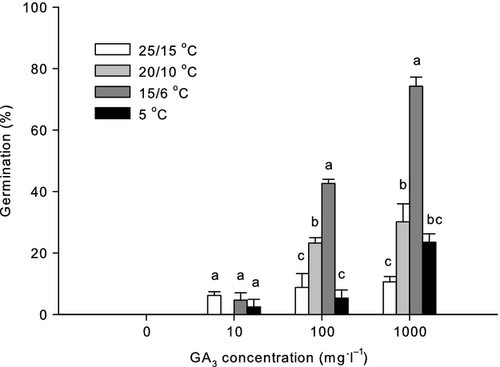
Discussion
Seeds of J. dubia imbibed water readily, increasing in mass by 113.6% after 6 h under ex situ conditions, thus having no PY (Fig. 1). The seeds have an underdeveloped embryo at the time of seed dispersal, thus they have morphological dormancy (MD) (Baskin & Baskin 1998; Lee et al. 2012). According to Baskin & Baskin (1998), seeds that begin to germinate within 30 days only have MD, and embryos begin to grow soon after the seeds imbibe water at favourable temperatures. However, none of the freshly harvested seeds of J. dubia germinated after several months of incubation at temperatures of 25/15, 20/10, 15/6 or 5 °C, indicating that they have morphophysiological dormancy (MPD) as well as MD (Fig. 3).
Baskin & Baskin (1998) classified eight basic types of MPD. These eight types of MPD are divided into two categories: simple and complex. In seeds with simple MPD, high or moderate (usually 15 °C or above) temperatures are required for embryo growth, and in those with complex MPD low (0–10 °C) temperatures are required for embryo growth. In our experiments, exposure of J. dubia seeds to a sequence of temperatures from warm to cold showed that the embryos began to grow at 25/15 °C (Fig. 4A). Embryos incubated at 25/15 °C for 12 weeks grew rapidly to full length when moved to moderate temperatures (20/10 °C and 15/6 °C), followed by cold (5 °C) temperatures. In natural conditions (Fig. 2), embryo growth and seed germination were similar to those observed under simulated seasonal temperatures in the laboratory (Fig. 4A). However, when seeds were initially incubated at 5 °C in the temperature sequence, embryo growth was delayed until exposure to 25/15 °C (Fig. 4B). Thus, moderate temperature (warm stratification) is first required for embryo growth, indicating that seed of J. dubia has simple MPD. Low temperature might be necessary for embryo growth because the embryo kept growing at 5 °C after the seeds had been exposed to 25/15 °C → 20/10 °C → 15/6 °C (Fig. 4). However, we consider that the seeds might respond to a wider the range of temperature after warm stratification. In seeds with PD, during progression from dormancy to non-dormancy, the temperature range at which seeds can germinate gradually increases (Baskin & Baskin 1998). The MPD types can be subdivided further, depending on the level of physiological dormancy, into: non-deep, intermediate and deep. Although GA stimulates the germination of seeds with non-deep and intermediate PD, it does not break deep PD in intact seeds (Nikolaeva 1977). In seeds with deep PD, GA promotes growth of the embryo, but does not stimulate germination. GA3 increased the rate of embryo growth in J. dubia, indicating that GA3 substituted for warm stratification for embryo growth (Fig. 6A). However, few seeds treated with GA3 and maintained at 20 °C germinated (Fig. 6B). Therefore, GA3 did not substitute for the low temperature requirement for dormancy breaking, suggesting that seeds do not have either non-deep or intermediate simple MPD. Since (i) embryos grew at relatively high temperatures for seeds of J. dubia, (ii) GA3 only partially overcame dormancy, and (iii) warm followed by cold stratification was required to break dormancy, it is confirmed that seeds of this species have deep simple MPD.
J. diphylla (L.) Pers. is the other North American species in the genus Jeffersonia. Its seeds have deep simple MPD, requiring high (30/15 °C) followed by moderate (20/10 or 15/6 °C) temperatures for embryo growth (Baskin & Baskin 1989). Seeds with fully elongated embryos require pretreatment at low temperature (5 °C) for germination. Furthermore, GA3 can substitute for warm but not for cold stratification in seeds of this species. Thus, the temperature requirements from embryo growth to germination and the effects of GA3 in J. dubia seeds correspond well with those of J. diphylla. Distinction between these two species is shown in the morphology of the leaf shape and capsule opening (Hutchinson 1920), floral vasculature (Terabayashi 1981) and pollen exine (Loconte & Estes 1989). However, it appears that these two eastern Asia–eastern North America disjuncts of Jeffersonia exhibit the same dormancy-breaking requirements. Although the two species live on different continents, the climate in these two regions is temperate, having four distinct seasons (Li 1952). Both grow on slopes with well-drained soil in rich deciduous forests (Wikipedia 2013). Seeds of an eastern Asia Panax species (Choi 1977) and those of a Taxus species (Chien et al. 1998) have deep simple MPD, which is the same type of MPD found in an eastern North American species of Panax (Stoltz & Snyder 1985) and of Taxus (Nikolaeva et al. 1985), respectively. Therefore, Baskin & Baskin (1989) reported that identical types of MPD in eastern Asian–eastern North American disjuncts that are members of the genera with an Arcto-Tertiary distribution are evidence that this type of dormancy is at least as old as the Tertiary.
Nikolaeva (2001) stated that seeds with MPD come out of dormancy in three stages: (i) PD is broken in the underdeveloped embryo, (ii) the underdeveloped embryo grows and becomes fully developed inside the seed (what Nikolaeva called embryo post-development), and (iii) PD is broken in the seed that now has a fully developed embryo. According to Nikolaeva's system (Baskin & Baskin 2008), this kind of seed dormancy is classified as C1b–B–C3. (i) The fresh seeds have underdeveloped embryos with non-deep PD (C1) of the C1b subtype, thus requiring warm stratification (subscript b) for the dormancy-break. (ii) Following the breaking of C1b, the underdeveloped embryo, now with only MD (B), grows to full size (post-development) at warm temperatures. (iii) Finally, the seed with a fully developed embryo germinates after a long period of cold stratification (C3).
Experiments in controlled conditions have shown that a pre-treatment at temperatures (warm stratification) of 25 and 25/15 °C for 8 weeks was effective in breaking dormancy (Table 1). Intermediate temperature pre-treatments (20 and 20/10 °C) were not effective in breaking dormancy and resulted in <50% germination. However, in seeds of Corydalis solida with deep simple MPD, incubation at 15/6 and 20/10 °C is required to initiate embryo growth, while high temperature pre-treatments (23 and 30 °C) are ineffective in breaking dormancy (Vandelook & Van Assche 2009). In nature, although seeds with MPD are exposed to a long period of relatively high temperatures in the summer, the optimum temperature needed to break PD differs between species. The E:S ratio was only 0.471 in seeds incubated continuously at 25/15 °C for 52 weeks (Fig. 3). However, embryo growth was completed at moderate temperatures, after the seeds had been subjected to warm stratification for about 12 weeks (Fig. 4A). There is variation among species with regard to the timing of embryo growth (Yang et al. 2011): in Taxus mairei (Chien et al. 1998), embryo growth occurs during warm stratification; in J. dubia and J. diphylla (Baskin & Baskin 1989), embryo growth occurs after warm stratification; and in Cephalotaxus wilsoniana (Yang et al. 2011), embryo growth does not occur until after both warm and cold stratification.
The GA treatment promoted both embryo growth and the germination of seeds with non-deep and intermediate simple MPD in some species, such as Chaerophyllum tainturieri, Aralia mandshurica and Dendropanax japonicum (Baskin & Baskin 1998). On the other hand, GA did not promote germination of seeds with deep simple MPD, e.g. Fraxinus excelsior (Wcislinska 1977) Panax ginseng (Choi 1977), J. diphylla (Baskin & Baskin 1989) and J. dubia (present study, see Fig. 6). However, about 70% of J. dubia seeds had germinated within 12 weeks when seeds were treated with 1000 mg·l−1 GA3 followed by incubation at 15/6 °C (Fig. 7). Following treatment with GA, germination was better at alternating temperature (15/6 °C) than at constant temperature (20 °C). It is well known that a fluctuating temperature regime is an absolute requirement for germination of many species (Probert 1992). In Cynara cardunculus, the germination of seeds incubated under the alternating temperature 25/15 °C was promoted compared to under a constant temperature of 20 °C (Huarte & Benech-Arnold 2010). Alternating temperatures broke dormancy of C. cardunculus seeds by an increase in GA biosynthesis and a decrease in ABA sensitivity. However, this is different from our case, because incubation at 25/15 °C after 1000 mg·l−1 GA3 treatment resulted in ≤10% germination. Deep simple MPD contains two parts of PD (Baskin & Baskin 1998): the embryo cannot be grown until (i) high temperatures (warm stratification) overcome the first part of PD, and (ii) seeds are subjected to moderate temperatures. After completion of embryo growth, seeds cannot germinate until low temperatures (cold stratification) overcome the second part of PD; the second part of PD was broken by prolonged low temperature (Fig. 5). It is well known that GA substitutes for warm stratification and stimulates embryo growth (Baskin & Baskin 1998), and we assumed that incubation temperature regime of 15/6 °C acted as moderate as well as low temperature at the same time. In particular, temperatures of 15 and 6 °C might act as the moderate temperature for embryo growth and as the subsequent low temperature condition required for completion of radicle protrusion, respectively. However, germination was inhibited when GA-treated seeds were incubated at a constant 5 °C. Following the warm stratification, a moderate temperature was also important for embryo growth (Baskin & Baskin 1998).
Results of this study show that two eastern Asia–eastern North America disjuncts of Jeffersonia have the same type of seed dormancy, despite the fact that they grow in different habitats. The dormancy of J. dubia seed is broken by warm stratification (at 25/15 or 25 °C for 8 weeks) followed by cold stratification (at 5 °C for 8 weeks). Although seeds of J. dubia in nature require about 10–11 months from seed dispersal to germination, seeds can germinate within 3 months with 1000 mg·l−1 GA treatment accompanied by incubation at 15/6 °C. The results presented here will allow horticulturalists and seed ecologists to increased the rate of seedling production from seeds with deep simple MPD.
Acknowledgements
This research was supported by the Korea Institute of Planning and Evaluation for Technology of Food, Agriculture, Forestry and Fisheries (Project No: 109096–5).



